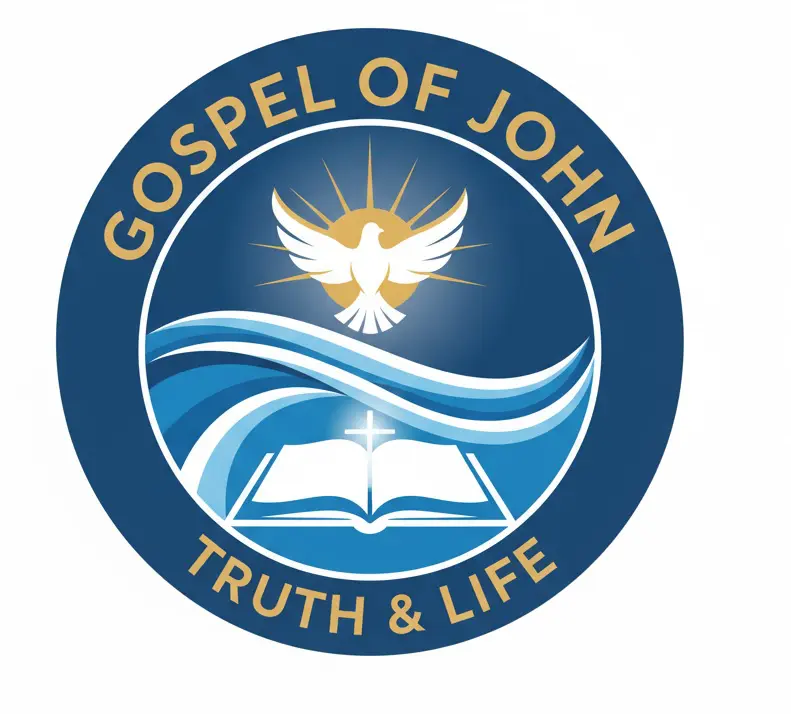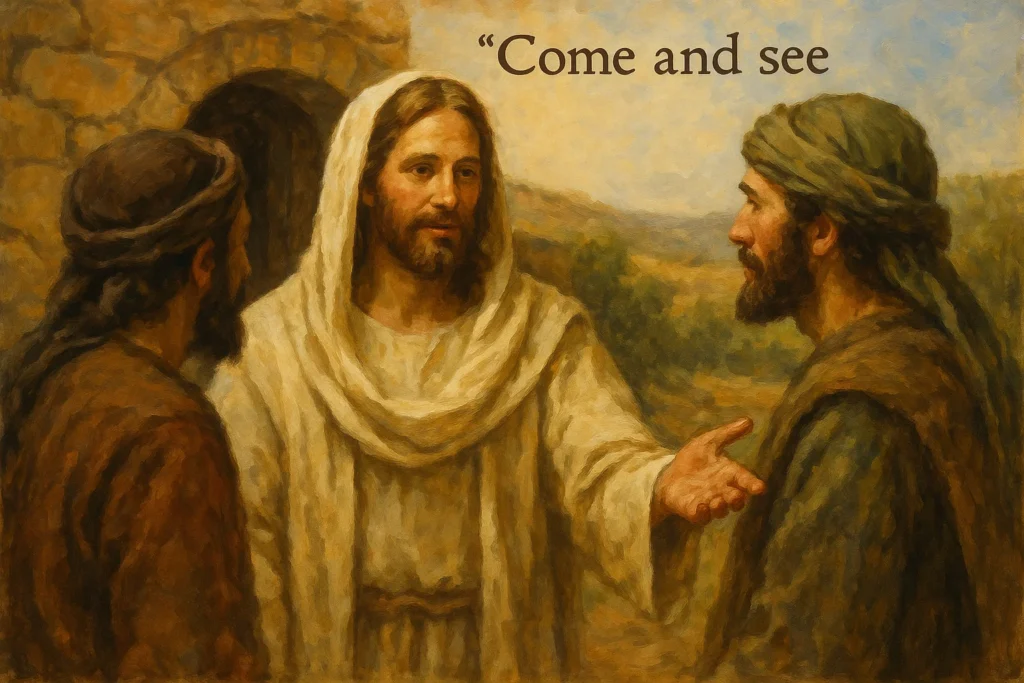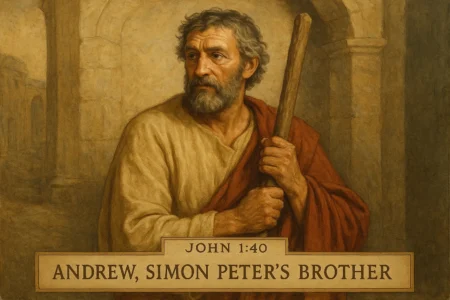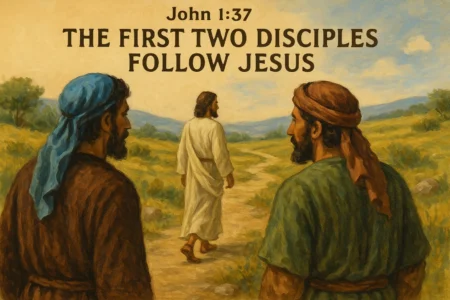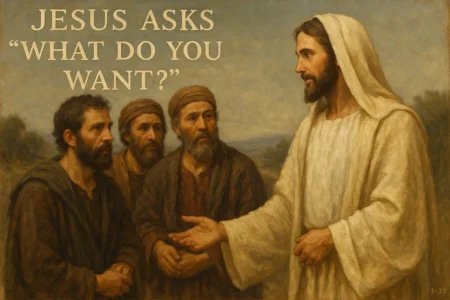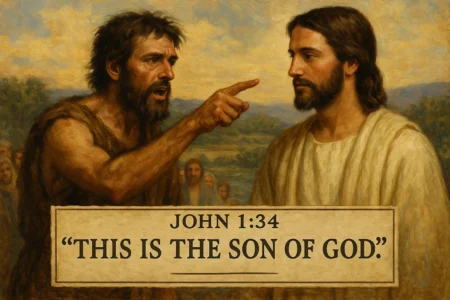Life is loud, isn’t it? Our phones buzz. Our inboxes pile up. We get hundreds of “invitations” a day—most of them are just noise, asking for our time, our money, or our attention. It’s easy to become numb to all of it.
But every once in a long while, a different kind of invitation comes along. It’s not just an “ask.” It’s a hinge. A moment that splits your life into “before” and “after.”
Now, picture this. A dusty road. Two men, disciples of a wild prophet, are staring at the back of a man walking ahead. Their teacher just pointed at him and said something world-changing: “Behold, the Lamb of God.”
Their curiosity is on fire. They’ve heard the prophecies. Now they see the person. So they follow. Hesitantly, I’d imagine. I know I’d be nervous.
The man turns. He stops. He sees them. He doesn’t get annoyed or call for security. He just… looks at them. And He asks a simple, profound question.
“What do you seek?”
They stammer out a reply, “Rabbi… where are you staying?”
And then comes the invitation. It’s not a 10-point plan. It’s not a list of doctrines. It’s just three simple words. “Come and see.” This is John 1:39.
This simple phrase is the very heartbeat of the Christian faith. It’s an invitation that has echoed for 2,000 years, daring us to move past secondhand information and into a firsthand experience. Exploring the John 1:39 meaning isn’t just for a Bible study; it’s about understanding the core of what it means to follow Jesus. It’s an invitation not to a system, but to a person.
More in John Chapter 1 Category
My Key Takeaways
- It’s Personal, Not a Mass-Mailing: This wasn’t a public sermon. Jesus was talking directly to two specific guys, Andrew and John, inviting them to move past hearing about Him and to experience His life for themselves.
- From “Data” to “Relationship”: The “John 1:39” is about the pivot. It’s the moment they stopped reading the “brochure” (what John the Baptist said) and decided to “tour the campus.”
- The Real Goal of Discipleship: They came to “see,” but the text says they “stayed with him.” This is the whole model. Discipleship isn’t a quick look; it’s learning to abide, to remain.
- An Offer, Not a Doctrine: Jesus doesn’t hand them a textbook. He offers them His time and His life. It’s a call to investigate, and that investigation leads to transformation.
- A “Pay it Forward” Model: This “Come and see” idea is so powerful that it’s the first thing the new disciples do. They immediately use it on their own friends.
What Was Happening Right Before Jesus Said “Come and See”?
To really get the punch of John 1:39, you have to back up a few verses. You can’t just parachute in. The scene is electric. John the Baptist, the most famous and feared prophet of his day, is with two of his own disciples. He sees Jesus walking by and declares, for the second time, “Behold, the Lamb of God!”
This isn’t a casual nickname.
That phrase is loaded. It’s a powerful, sacrificial, and redemptive title. For a first-century Jew, it would have been a complete show-stopper. It pointed to the Passover lamb, to the suffering servant in Isaiah, to the one who would, somehow, take away the sins of the world.
The two disciples, Andrew and the one we assume is John (the author of this Gospel), hear this. This is their teacher, the man they’ve given their lives to, pointing to someone else and saying, “He’s the one.”
Their loyalty to John was good. But John himself was pointing them beyond himself.
So they follow.
You have to imagine that moment. The sound of their sandals on the dirt path. The nervous energy. They’re tailing a man who’s just been given the most explosive title in their theological world.
And then, Jesus turns.
He stops, looks them right in the eye, and asks, “What do you seek?”
It’s the first question Jesus asks in the Gospel of John, and it’s a question for every last one of us. He’s not just asking “What’s up?” He’s asking, “What is the deepest, truest desire of your heart? What are you really looking for?”
Why Did They Ask “Where Are You Staying?”
Their answer is almost comically awkward. “Rabbi,” (which means Teacher), “where are you staying?”
On the surface, it’s a simple logistical question. “What’s your address?”
But the Greek word here, meneis, is a huge theme in John’s Gospel. It doesn’t just mean “staying” in a temporary sense, like at a motel. It means “to abide,” “to dwell,” “to remain.”
They’re not just asking where He’s sleeping tonight. They are, in a fumbling, perfectly human way, asking something much deeper. “Where do you live?” “What is your home?” “Where do you abide?”
It’s a clumsy-but-beautiful request for intimacy. They’re essentially saying, “We want to know you. We want to see your life, up close. Can we just… be where you are?”
They’re asking for more than a lecture. They’re asking for access.
And Jesus, in His brilliance, understands the question beneath their question. He doesn’t give them an address. He gives them an invitation.
“Come and see.”
So, What Is the Real John 1:39 Meaning?
This is it. The core. “He said to them, ‘Come and see.’ So they came and saw where he was staying, and they stayed with him that day, for it was about the tenth hour.”
This invitation is the key that unlocks the entire Gospel. It is profoundly simple and shockingly deep. Jesus is essentially saying, “You want to know where I abide? Don’t let me just tell you. Let me show you. Come experience it for yourself.”
The meaning of John 1:39 is that faith in Jesus is not a set of secondhand reports. It’s not a philosophy to be debated or a creed to be memorized (though those things have their place).
At its heart, faith in Jesus is an experience. It’s an encounter.
Is It More Than a Simple Invitation to Dinner?
You bet it is. Jesus’s response, “Come and see,” is a direct answer to their deeper question about where He abides. He is inviting them into His personal space, His life.
This is the ultimate “E-E-A-T” (Experience, Expertise, Authoritativeness, Trustworthiness) moment. Jesus isn’t asking for blind faith. He’s so confident in the truth of who He is that He invites scrutiny. He says, “Don’t take John’s word for it. Don’t take anyone else’s word for it. You come. You look. You see for yourself.”
A charlatan would never do this. A fake deflects and gives you theories. A person who is the truth throws the doors open and says, “Come on in. Look around.”
He’s offering transformation, not just information. And that’s a crucial difference. Information can be argued with. An experience, however, changes you.
Have You Ever Had a “Come and See” Moment?
It reminds me of when I was picking a college. I’m a guy who loves research. I read all the brochures. I analyzed the websites. I compared statistics, faculty-to-student ratios, and campus dining reviews. I had a whole spreadsheet. I knew everything about these schools. My parents were convinced I was ready to apply.
But I still didn’t know. Not really.
Finally, I visited my top-choice campus. I walked under the old brick archways. I sat in on a class. I ate the (admittedly mediocre) dining hall food. I talked to a few students who were just… real. I spent a day just abiding in that place.
By the time I drove home, the spreadsheet didn’t matter. I knew. I had moved from “hearing about it” to “seeing it” for myself. I had my “come and see” moment.
That’s what’s happening here. Andrew and John had all the information. They had the “Lamb of God” prophecy from a trusted source. But Jesus knew that wasn’t enough. They had to see for themselves.
Why Doesn’t Jesus Just Answer Their Question?
He could have.
He could have said, “I’m staying at Peter’s mother-in-law’s house on the west side of town. Here’s a map.”
But that would have just been information. It would have satisfied their minds but left their hearts untouched. If He had just given them an address, they might have said, “Oh, okay, thanks!” and walked away.
Jesus is always more interested in relationship than in transactions. He’s inviting them into His life, not just His temporary lodging. By saying “Come and see,” He is offering them Himself. He’s offering them his time, his presence.
The answer to “Where do you abide?” isn’t a location. It’s a person.
What Does “They Stayed With Him That Day” Really Mean?
This little detail is one of my favorite parts of the story. “So they came and saw where he was staying, and they stayed with him that day, for it was about the tenth hour.”
The “tenth hour” by Jewish timekeeping was about 4 PM.
This is huge.
They didn’t just have a quick 10-minute chat. They didn’t just pop in, look around, and leave. They showed up at 4 PM, and they stayed. They spent the rest of the day and the entire evening with Jesus.
This was the first “small group.”
The text is beautifully silent on what they talked about. As a writer myself, I love that John leaves this to our imagination. Did they talk about the prophecies? Did they ask Him about the “Lamb of God” title? Did they share their own hopes and fears for Israel?
Probably all of it. But the content of the conversation isn’t the point. The communion is. They “stayed with him.” They “abode.”
They came looking for a place, and they found a person.
How Did This One Afternoon Change Everything?
The proof is in the pudding. The John 1:39 meaning is validated by what happens immediately after. The experience was so profound, so utterly convincing, that it led to immediate, certain action.
What does Andrew do the very next morning?
“He first found his own brother Simon, and said to him, ‘We have found the Messiah’ (which is, being interpreted, the Christ).”
Notice his words. He doesn’t say, “I met a really interesting teacher, you should check him out.” He doesn’t say, “I had a good discussion with a new Rabbi.”
He says, with total, unshakeable conviction, “We have found Him. The One. The Messiah.”
That is the result of “coming and seeing.” It’s the difference between “I think so” and “I know.” That one afternoon and evening with Jesus completely changed Andrew’s life, and through him, it changed his brother Peter’s life. And that, as we know, changed the world.
Is This Invitation to “Come and See” Still Open Today?
This is the “so what” for us, isn’t it? It’s a great story. But is it just a 2,000-year-old historical event?
No. The invitation of John 1:39 is the standing invitation of Christianity. It did not expire with Andrew and John. It’s an open call to every person in every generation.
The John 1:39 is that Jesus is still saying, “Come and see.”
How Do We “Come and See” in the 21st Century?
We can’t physically walk to Galilee and knock on His door. So how does this work for us?
It’s about engaging with Him on the terms He has given us, with the same openness that Andrew and John had.
- Through His Words: We “come and see” by opening the Gospels (like this one from John) and reading them not as ancient history, but as a living, breathing invitation. We ask, “Jesus, show me who you are,” and then we read.
- Through Prayer: Prayer is our version of “where are you staying?” It’s moving from talking about God to talking with God. It’s setting aside time to just “stay with him” for a while, to be silent, to listen.
- Through Community: We “come and see” by engaging with the Church—other people who are also on this journey. When we serve together, worship together, and share our lives, we often see Jesus in a new way.
- Through Service: Jesus said that what we do “for the least of these,” we do for Him (Matthew 25). We “come and see” Him when we serve the poor, visit the sick, or welcome the stranger.
The invitation is the same. The methods are just adapted to our time.
Why Do We Settle for “Hearing” Instead of “Seeing”?
This is a human tendency, and I’m as guilty of it as anyone. Let’s be honest. It’s safer to just “hear about” God.
It’s safer to listen to a sermon, read a book, or have a theological debate. This keeps God at a manageable, intellectual distance. We can control the information.
“Coming and seeing” is different. It’s risky.
It demands a response. It means giving up control. It means we might be changed. It’s an invitation into the unknown, and that can be frightening.
I have to admit, for a long time, my own faith was what I had “heard.” It was the faith of my parents. It was the faith I learned in Sunday school. It was good, it was true, but it wasn’t mine. It was secondhand information. I was living off John the Baptist’s testimony, so to speak.
It wasn’t until I went through a personal crisis in my mid-twenties that I finally had to ask my own question. My life was a mess, and all the “information” I had about God wasn’t helping. I finally, desperately, asked, “Jesus, where are you? Where are you staying in all of this?”
I had to move from knowing about Him to “coming and seeing” for myself. It was the scariest, and best, thing I ever did. It’s the only thing that made my faith real. It stopped being a religion and started being a relationship.
What If I’m Afraid of What I’ll Find?
That’s a valid and honest fear. Andrew and John were probably nervous. They were leaving their life’s teacher, John the Baptist, to follow this new, unknown person.
“Come and see” is an invitation into the unknown.
But look at Jesus’s first question: “What do you seek?” He knows what we’re looking for. If what we’re seeking is truth, hope, purpose, or love, His invitation is gentle. It is not a threat. It’s an offer.
He meets us where we are. He doesn’t demand that we clean ourselves up before we come. He just says, “Come.”
The “Come and See” Pattern in the Gospel of John
The best part is that John doesn’t just give us this one story. He loves this “come and see” theme. It becomes the whole model for evangelism.
How Does Philip Use the Same Invitation?
The “come and see” virus is contagious. Immediately after this, Jesus finds Philip, who is from the same town as Andrew and Peter. Jesus gives him a simple, direct call: “Follow me.”
What does Philip do? He goes and finds his friend, Nathanael.
Philip, full of excitement, says, “We have found him of whom Moses in the Law and also the prophets wrote, Jesus of Nazareth, the son of Joseph!”
Nathanael, famously, is a skeptic. He scoffs, “Can anything good come out of Nazareth?”
What’s Philip’s answer? Does he get into a theological argument about Nazareth? Does he present a 10-point treatise on messianic prophecy?
No. He gives the exact same answer Jesus gave.
“Come and see.” (John 1:46)
Philip has learned the lesson in less than a day. Don’t argue. Invite. Don’t try to win a debate. Just get them in the same room with Jesus. The “John 1:39 meaning” is now a strategy.
What About the Samaritan Woman?
The pattern continues. In John 4, Jesus has a long, life-changing conversation with a Samaritan woman at a well. She’s an outcast, a woman with a broken past. He sees her, knows her, and offers her “living water.”
She is so completely astonished and transformed by this encounter that she leaves her water pot and runs back to her town.
And what does she say to the townspeople who had shunned her?
“Come, see a man who told me all that I ever did. Can this be the Christ?” (John 4:29).
It’s the same invitation. “Come and see.” Don’t take my word for it—I’m the town outcast. But just come and see for yourselves. And the text says the people went because of her testimony, and many believed.
This is the model. An encounter with Jesus leads to an invitation for others to “come and see.”
What Does This Mean for My Own Faith Journey?
This brings it all back to us. The John 1:39 is the perfect antidote to a stale, boring, secondhand faith.
Are you feeling stuck in your faith? Does God feel distant? Does it all feel like a list of rules you “should” be following?
Maybe it’s because you’re living off what you’ve “heard” instead of what you’ve “seen.” You’re living off someone else’s experience.
The invitation is to move from information about God to an encounter with God.
Moving from “What Do You Seek?” to “Come and See”
It’s a simple process, modeled perfectly by these first disciples.
- Acknowledge Your Seeking: Be honest with yourself and with God. What are you really looking for? Jesus’s first question is still “What do you seek?”
- Ask Your Question: Don’t be afraid to ask your “where are you staying?” question. “God, where are you in my life? Where do you abide? I want to know you.”
- Accept the Invitation: When you hear that quiet, inner nudge—”Come and see”—accept it. This means setting aside the time. Put the phone down. Open the Bible. Go for a walk and just talk to Him.
- “Stay” for a While: Don’t rush it. The disciples “stayed with him that day.” You can’t microwave a relationship. Give it time. Give it that 4 PM-to-the-next-morning kind of unhurried, undistracted time.
The Ultimate “Come and See”: An Invitation for All Time
The invitation that Jesus gave to two men on a dusty road is the same invitation He extends to every skeptic, every seeker, every religious person, and every “none-of-the-above.”
It’s a call to move beyond assumptions, beyond what you’ve heard, and beyond your own prejudices.
The invitation is to experience a truth so profound it’s been the subject of study for millennia. Scholars at institutions like Harvard Divinity School and around the world continue to explore the historical and theological depths of these texts, but the core invitation from Jesus remains profoundly personal and simple.
The John 1:39 meaning is that Jesus doesn’t want to be studied as much as He wants to be known. He is not a problem to be solved; He is a person to be met.
It all started with two men. A simple question. A life-changing invitation.
“Come and see.”
Three words that bridge the gap between human curiosity and divine conviction. This isn’t just a historical event; it’s a present-day reality.
The question Jesus asked them, “What do you seek?” is still hanging in the air.
And His answer, if we’re brave enough to ask our question, is still the same.
It’s an invitation to experience Him for yourself.
“Come and see.”
FAQ – John 1:39 Meaning
What is the significance of the phrase ‘Come and see’ in John 1:39?
The phrase ‘Come and see’ is Jesus’s personal invitation for those seeking to experience His life firsthand, moving beyond secondhand information to a direct encounter with Him.
How does the ‘Come and see’ invitation relate to discipleship?
It emphasizes that discipleship is about remaining with Jesus, experiencing His presence personally, rather than just learning about Him through doctrines or secondhand reports.
Why did the disciples ask Jesus where He was staying, and what is its deeper meaning?
They asked this question to inquire about where Jesus abides or dwells, symbolizing their desire for intimacy and access to His life and presence, not just a physical location.
What does the detail about the disciples staying with Jesus until the tenth hour reveal?
It shows that they spent a significant, unhurried part of the day with Jesus, indicating the importance of lingering and abiding in an authentic relationship with Him.
How can we apply the ‘Come and see’ invitation in our modern faith journey?
We can engage with Jesus through His Word, prayer, community, and service, welcoming Him into our lives and allowing personal encounters to transform our faith.
